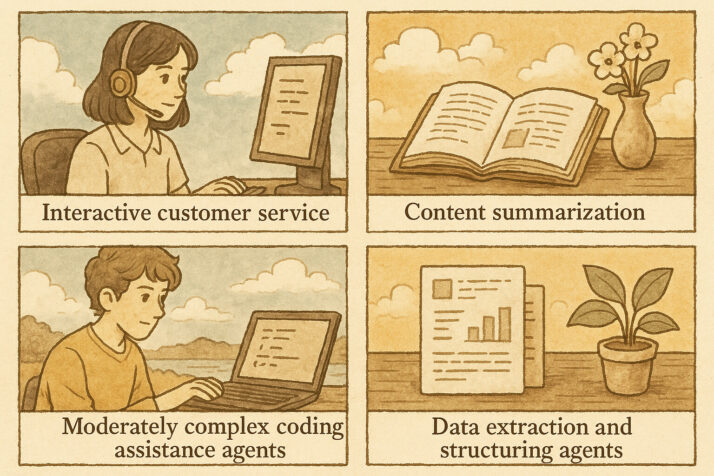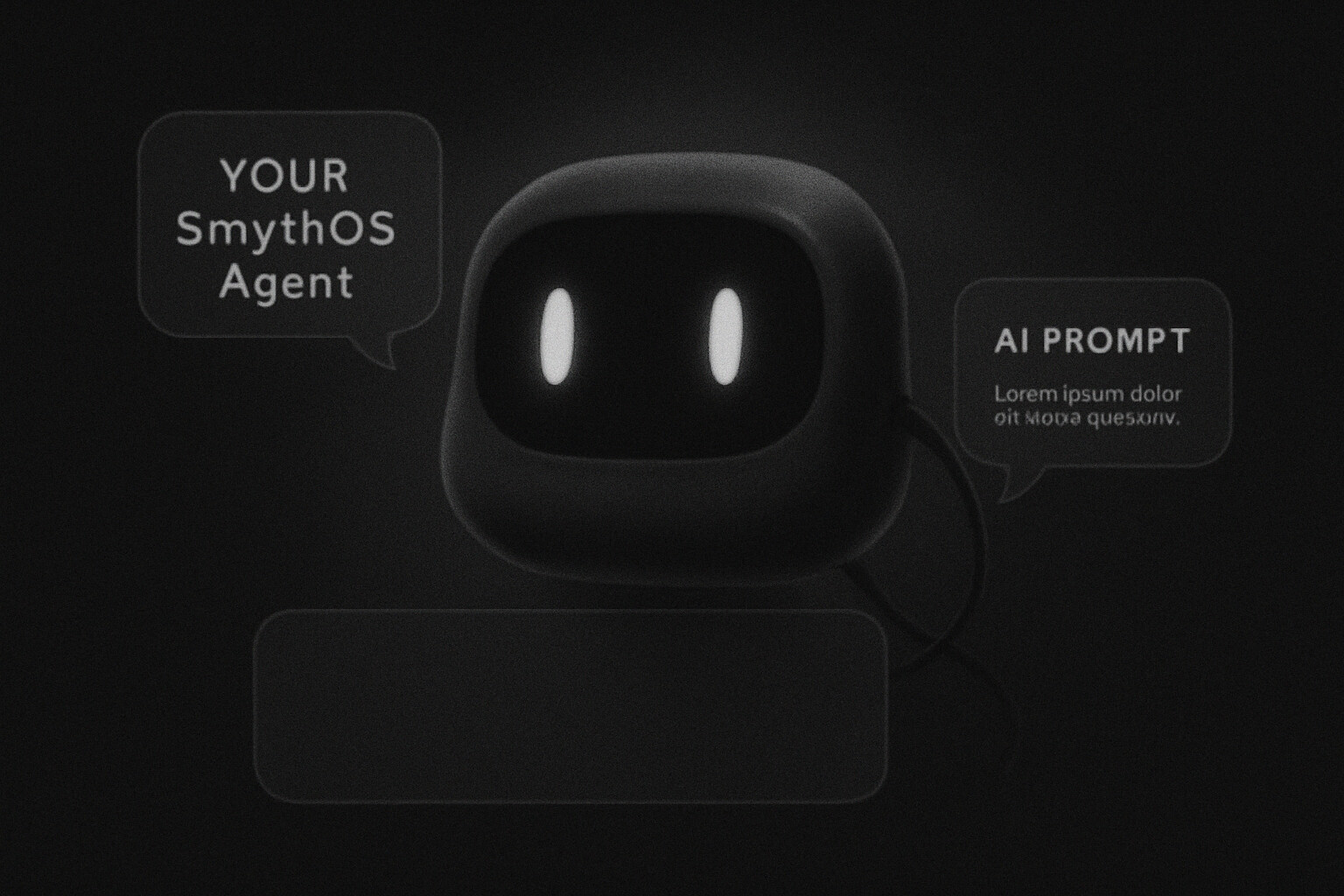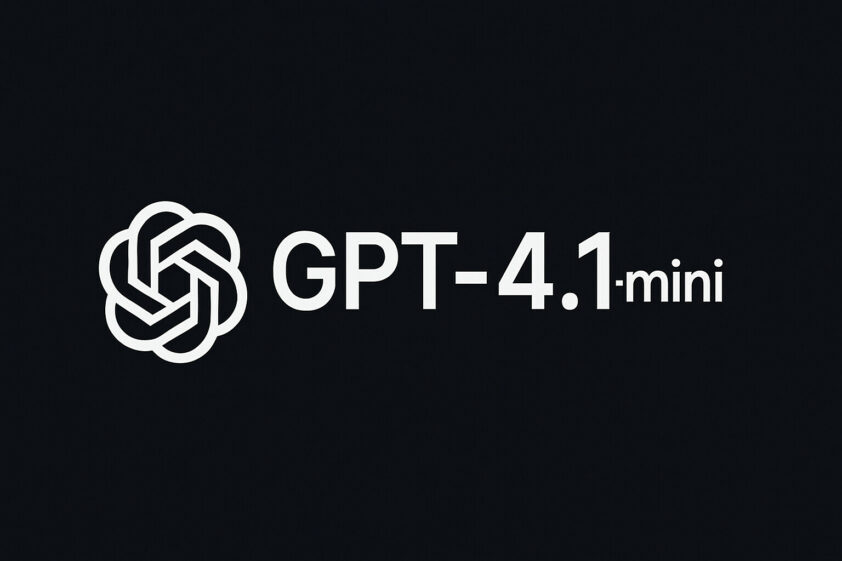Building responsive, intelligent AI agents has always involved trade-offs—between performance and cost, speed and accuracy, or power and practicality.
Developers often find themselves forced to choose between using large, expensive models that are powerful but slow, or lightweight models that are fast but lack critical reasoning capabilities. For business owners, this balancing act can translate into higher infrastructure costs, sluggish user experiences, or unreliable automation tools.
GPT-4.1 mini changes that equation.
Designed as a high-performance, low-latency model, GPT-4.1 mini offers a compelling middle ground. It delivers intelligence levels that rival or exceed GPT-4o, while cutting latency nearly in half and slashing cost by more than 80%. That means developers can now build smarter, faster agents without burning through compute budgets. At the same time, business owners can finally scale AI automation without compromising user experience.
GPT-4.1 mini allows you to deploy AI agents that respond quickly, follow instructions reliably, and make better decisions—all at a fraction of the usual cost.
What is GPT-4.1 mini?
GPT-4.1 mini is part of the newly launched GPT-4.1 family, sitting between the full GPT-4.1 model and the ultra-light GPT-4.1 nano. What makes GPT-4.1 mini unique is its ability to deliver top-tier performance on intelligence benchmarks—often surpassing GPT-4o—while remaining optimized for speed and affordability.
With support for up to 1 million tokens of context, GPT-4.1 mini can handle long-form data like technical documentation, customer histories, or codebases without losing track of the thread. It’s especially well-suited for applications that require nuanced reasoning across multiple messages or instructions, but can’t afford the latency or cost of a full-scale model.
Benchmark results speak to its capabilities: GPT-4.1 mini outperforms GPT-4o on tasks involving coding, instruction-following, and visual understanding. It even holds its own against larger models like GPT-4.5 in some areas—all while delivering lightning-fast responses and predictable performance.
This makes GPT-4.1 mini an ideal foundation for AI agents that need to think clearly, act quickly, and operate within a budget.
GPT-4.1 mini vs GPT-4o mini: A Smarter, Faster Middle Ground
Yes, GPT-4.1 mini is a smaller model. However, it’s also a breakthrough in balancing intelligence, speed, and cost.
While GPT-4o mini was already an efficient model, GPT-4.1 mini outperforms it across nearly every meaningful benchmark, making it the clear choice for developers and businesses seeking to build smarter AI agents without breaking the bank.

One of the most striking differences is how well GPT-4.1 mini handles instructions. On Scale’s MultiChallenge benchmark, which evaluates a model’s ability to follow multi-turn prompts and maintain context over time, GPT-4.1 mini scores 36%. That’s nearly doubling GPT-4o mini’s 20%.
As a result, GPT-4.1 mini is far more dependable for agents involved in task orchestration, customer support, or anything requiring step-by-step guidance.

In terms of coding, the gap is even wider. On Aider’s polyglot diff benchmark—used to test a model’s ability to edit code efficiently—GPT-4.1 mini achieves a 45% accuracy score. Meanwhile GPT-4o mini struggles at just 3%.
For developers building agents that perform code reviews, generate patches, or create diffs for continuous integration workflows, GPT-4.1 mini is clearly the superior tool.

When it comes to formatting and compliance with output structure, GPT-4.1 mini also demonstrates a stronger grasp. On OpenAI’s IFEval, which measures how well a model follows formatting instructions, GPT-4.1 mini scores 84% compared to GPT-4o mini’s 78%. This matters for use cases where structured output is essential—like generating HTML, Markdown, or structured JSON responses for APIs.

Visual reasoning is another area where GPT-4.1 mini pulls ahead. On tests like MMMU and MathVista, which challenge the model’s ability to interpret diagrams, maps, and math-based visuals, GPT-4.1 mini consistently outperforms GPT-4o mini. This makes it a solid choice for agents that need to interact with dashboards, graphs, or any visual inputs common in enterprise tools.

Long-context comprehension is where GPT-4.1 mini becomes a true standout. Both models can handle up to 1 million tokens of context, but GPT-4.1 mini is significantly better at retrieving and reasoning across that vast input space. On OpenAI’s Graphwalks benchmark, designed to test multi-hop reasoning across documents or datasets, GPT-4.1 mini scores 62%—more than double GPT-4o mini’s 29%. This means your agents can scan, process, and act on dense information with far greater reliability.
All of this is wrapped in a performance profile that’s incredibly efficient. GPT-4.1 mini is almost twice as fast as GPT-4o mini and reduces cost by 83%, making it ideal for scaling intelligent agents across products or business units without sacrificing quality or speed.
In short, GPT-4.1 mini isn’t just a more affordable option—it’s a dramatically smarter and more capable foundation for practical AI agent development.
Ideal Use Cases of GPT-4.1 mini for AI Agents

GPT-4.1 mini is built for developers and businesses who want smart, reliable agents that can operate at scale—agents that don’t just respond quickly, but respond well.
Interactive Customer Service Agents
GPT-4.1 mini strikes an ideal balance for customer-facing AI agents that need to be smart, fast, and scalable. Its low latency allows for snappy, human-like responses, while its strong instruction-following and 1 million token context window enable the agent to retain memory over long support threads or access detailed internal documentation.
Businesses can also fine-tune GPT-4.1 mini to match brand voice or specific product knowledge, making it a powerful engine for chatbots, support assistants, and help desk automation—without the overhead of a larger model.
Content Summarization & Generation Agents
For content-heavy workflows, GPT-4.1 mini offers the ability to process and summarize long-form materials such as whitepapers, meeting transcripts, or technical manuals.
It can also generate marketing copy, internal reports, or blog articles based on structured input—all while keeping operational costs low. Thanks to its long-context comprehension, it can absorb detailed prompts and nuanced source material, making it especially useful for editorial teams, knowledge managers, and marketing departments looking to scale output with consistency and accuracy.
Moderately Complex Coding Assistance Agents
While it may not replace GPT-4.1 in highly advanced software development use cases, GPT-4.1 mini is more than capable of supporting everyday developer tasks.
It can explain code logic, generate boilerplate, help with simple debugging, or even translate between programming languages. Its improved performance over GPT-4o makes it a cost-effective solution for agents integrated into IDEs, internal dev tools, or GitHub workflows where instant suggestions and code reviews are needed without excessive resource drain.
Data Extraction and Structuring Agents
When paired with structured prompts, GPT-4.1 mini becomes highly effective at pulling key information from long documents, transcripts, or web content. Its ability to maintain context across thousands of tokens allows it to extract entities like names, dates, invoice amounts, or legal clauses with precision.
This makes it a great fit for building agents that transform raw content into structured formats such as JSON, CSV, or database entries—ideal for document processing pipelines or backend automations.
Internal Enterprise Tools & Automation Bots
In business environments where cost-efficiency and reliability matter, GPT-4.1 mini is a strong contender for powering internal AI tools.
From answering employee questions based on policy manuals and knowledge bases to scheduling meetings or streamlining onboarding workflows, the model handles a wide range of everyday tasks with competence. Its suitability for chained or parallel model calls also makes it useful in more complex workflows involving multiple decision points or integrations across enterprise systems.
Practical Guide: How to Use GPT-4.1 mini API in Your AI Agent
GPT-4.1 mini offers all the tools necessary for robust, scalable AI agents—provided you approach implementation with the same care you’d give to any production-grade system.

How to Set Up GPT‑4.1 mini in SmythOS Agent
Getting started with GPT‑4.1 in SmythOS is simple—no manual API setup required. SmythOS comes with native support for GPT‑4.1 mini built right into its LLM component, making it easy for teams to integrate this powerful model into their AI agents.
To begin, add an LLM component to your agent flow. From the dropdown list of available models, select gpt-4.1 mini. That’s it—no need to copy API keys or configure endpoints manually. SmythOS handles the integration behind the scenes so you can focus on building intelligent behaviors.
This built-in support allows your agents to immediately take advantage of GPT‑4.1’s strengths. Since SmythOS is designed for real-world deployment, you can pair GPT‑4.1 mini with other components — like for Nodejs, web search, and web scrape — to build powerful, multi-step agents without writing boilerplate code.
When building agents that operate in real time, speed matters. GPT-4.1 mini is already faster than previous models, but you can push latency even lower by enabling prompt caching. This is especially useful when your agent works off recurring documents or template-based interactions. Cached prompts receive a 75% discount on input cost, which adds up quickly at scale.
You should also consider the model’s parallelizability. GPT-4.1 mini performs well in workflows where multiple models run simultaneously—such as extracting different types of data from the same input, or routing sub-tasks to specialized prompt chains. This enables more complex behavior without needing a heavyweight model at each step.
Finally, take advantage of fine-tuning support. For agents that need to mirror your brand voice, follow specific workflows, or respond to sensitive topics with tailored nuance, fine-tuning GPT-4.1 mini can dramatically boost accuracy and reduce the need for repeated post-processing or filtering logic.
Crafting Effective Prompts for Smarter Agents on GPT-4.1 mini
The intelligence and responsiveness of your AI agent depends heavily on how you prompt it. GPT-4.1 mini excels when given clear, structured, and purpose-driven instructions—especially in multi-step tasks or when working with large inputs. To harness its full capabilities, prompt design needs to be both intentional and adaptive to your agent’s domain.
Be Explicit:
Instead of relying on the model to “guess” what you want, lay out clear instructions, including formatting requirements, tone, and content constraints. For example, if your agent is generating structured data, specify the exact output format (like JSON or Markdown) within the prompt. GPT-4.1 mini follows formatting instructions more reliably than previous models, making this approach especially effective.
Use Ordered Instructions:
Use ordered instructions when your agent is expected to complete tasks in a specific sequence—such as asking a user’s name before proceeding to the next input. You can also improve reliability by listing all requirements up front, like character limits, word counts, or details to include or avoid.
Include Examples:
Few-shot prompting (showing sample inputs and outputs) helps the model align with your intended structure and tone, especially for tasks like classification, content rewriting, or query parsing. GPT-4.1 mini is highly responsive to pattern-based prompts, which makes example-driven approaches particularly powerful.
Account for Negative Instructions:
If there are behaviors your agent should avoid—such as making assumptions, repeating itself, or referencing internal systems—be explicit about what not to do. GPT-4.1 mini handles these “don’ts” more reliably than many prior models.
Test for Edge Cases:
Run your agent through prompts that might confuse or mislead weaker models—such as ambiguous commands, missing data, or requests with contradictory instructions. GPT-4.1 mini tends to perform well in these scenarios, but refining your prompts around known friction points helps ensure your agent responds consistently and with higher confidence.
By treating prompt design as an iterative process and tailoring your instructions to the strengths of GPT-4.1 mini, you can dramatically improve agent accuracy, reduce hallucinations, and build systems that feel more reliable and intelligent to users.
The Real-World Impact of GPT‑4.1 mini on AI Agent Development

While benchmarks offer valuable insight, it’s the real-world deployment of GPT-4.1 mini that truly highlights its strengths. Early adopters across industries have tested the model in live environments—building agents that are not only faster and more affordable, but also smarter in practical, high-stakes workflows.
Take Hex, for example—a company that builds collaborative data tools. In their most challenging SQL evaluation set, GPT-4.1 delivered a nearly 2× improvement in accuracy compared to GPT-4o.
It showed stronger semantic understanding and reliably selected the correct tables from large, ambiguous schemas. For AI agents tasked with assisting analysts, generating queries, or debugging database logic, this meant fewer errors, less manual oversight, and a shorter path to production-grade results.
Another case comes from Blue J, a legal technology company specializing in complex tax analysis.
In internal benchmarks focused on real-world tax scenarios, GPT-4.1 was 53% more accurate than GPT-4o. The model was able to understand nuanced legal context and follow structured instructions more faithfully—critical requirements for agents tasked with research, documentation drafting, or compliance review.
The model’s performance isn’t just about isolated accuracy—it also reduces inefficiencies.
Windsurf, a platform that builds AI-assisted coding workflows, reported a 60% boost in coding benchmark scores when switching from GPT-4o to GPT-4.1.
Developers found that agents powered by GPT-4.1 were 30% more efficient in tool calling and 50% less likely to repeat unnecessary edits or miss broader code context. For developer-facing agents, this translates to smoother iteration cycles and more reliable suggestions.
What these examples show is that the GPT-4.1 models aren’t just incremental update—they enables real, measurable improvements in how AI agents perform under real-world constraints.
Pricing and Cost Efficiency of GPT-4.1 mini
One of GPT-4.1 mini’s biggest advantages is how much power it delivers for its price. Designed to operate at a fraction of the cost of larger models—while still outperforming many of them in key benchmarks—it allows developers and business teams to build intelligent agents that are not only fast and capable, but also economically scalable.
At just $0.40 per million input tokens and $1.60 per million output tokens, GPT-4.1 mini is 83% cheaper than GPT-4o, making it one of the most cost-effective models available in the OpenAI API lineup. This reduced pricing dramatically lowers the barrier for building high-frequency agents, enabling use cases like customer support bots, daily report generators, or internal task runners to run continuously without spiraling costs.
When prompt caching is enabled, the savings get even better. GPT-4.1 mini qualifies for a 75% discount on cached input tokens, bringing the cost down to just $0.10 per million cached tokens.
This is especially useful in workflows where the same system prompt or reference document is reused frequently—like template-based content generation, document analysis, or assistant agents operating within a fixed domain.
| Model (Prices are per 1M tokens) | Input | Cached input | Output | Blended Pricing* |
|---|---|---|---|---|
| gpt-4.1 | $2.00 | $0.50 | $8.00 | $1.84 |
| gpt-4.1-mini | $0.40 | $0.10 | $1.60 | $0.42 |
| gpt-4.1-nano | $0.10 | $0.025 | $0.40 | $0.12 |
Crucially, this lower cost doesn’t come with a trade-off in quality. GPT-4.1 mini frequently outperforms GPT-4o mini and rivals the larger GPT-4o in intelligence evaluations. In other words, you’re getting higher capability at a much lower price.
That kind of pricing-performance ratio is rare—and it gives startups, mid-sized businesses, and even large enterprises the flexibility to expand AI usage across departments or customer segments without multiplying infrastructure costs.
If you’re building multiple agents or running high-volume interactions, GPT-4.1 mini offers the kind of predictable, scalable pricing model that enables long-term deployment. And with support for OpenAI’s Batch API, you can reduce costs even further with up to a 50% discount on bulk processing tasks.
For anyone aiming to scale AI agent deployment—without sacrificing quality or breaking the budget—GPT-4.1 mini delivers one of the most attractive cost-performance profiles available today.
Conclusion: Using GPT-4.1 mini for Advanced AI Agent Creation
GPT-4.1 mini is a leap forward for anyone building intelligent, responsive, and cost-effective AI agents. With near GPT-4-level reasoning, a massive 1 million token context window, and lightning-fast latency, it enables a new generation of applications that were previously too expensive or too slow to build and scale.
Whether you’re automating customer support, summarizing complex documents, streamlining internal workflows, or assisting developers with real-time code analysis, GPT-4.1 mini gives you the performance you need at a fraction of the cost. Its reliability across multi-turn prompts, formatting accuracy, and structured output makes it a dependable engine for practical, production-grade AI systems.
But choosing the right model is only half the equation. You also need the right infrastructure to orchestrate your agents, chain tasks, and deploy workflows efficiently. That’s where SmythOS comes in.
SmythOS is a no-code platform purpose-built for AI agent development. It allows you to visually compose agent workflows, integrate GPT-4.1 mini through a simple drag-and-drop interface, and chain model outputs across tasks like parsing documents, generating responses, or querying APIs. Whether you’re deploying agents to Slack, Notion, web apps, or internal systems, SmythOS gives you the flexibility and control to operationalize GPT-4.1 mini with zero friction.
With SmythOS, you can move from idea to production faster—while leveraging the power, speed, and affordability of GPT-4.1 mini at every step.
